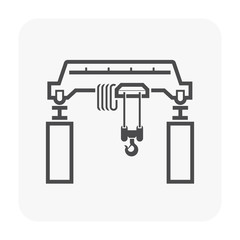Title Page
-
Crane Location
-
Crane ID
-
Crane Photo
-
Conducted on (Date and Time)
-
Inspected by
Safety Administration
-
Fire extinguisher present and in good working order.
-
Location of extinguisher
-
First aid kit (visible and stocked)
-
Location of first aid kit
-
Water provided.
-
Warning and hazard signs posted.
-
Hazard areas identified.
-
Is the rated load of the crane plainly marked?
-
Is the marking clearly visible & legible from a safe distance?
-
Is a clearance of 18 inches maintained laterally between the crane and the nearest obstruction?
-
Are only designated personnel permitted to operate the crane?
-
No overhead loads!
-
Ladder is present on TravelLifts and ShuttleLifts?
-
Ladder is in good condition?
PPE
-
FINFROCK required PPE.
-
Hard hats
-
Boots or safety shoes
-
Gloves
-
Long pants
-
High visibility
-
No earbud or headphone use.
-
TravelLift or ShuttleLift
-
Body harness for each crew member.
-
Harness in good working order?
-
Proper donning and adjustment of fall protection.
-
SRL for each crew member.
Safe Action
-
No overhead loads!
-
No unattended loads.
-
Alarm in use when load is in motion.
-
Hook and slings secured during transportation.
-
Boom is kept within tilt and skew tolerances (<10%)
-
Controls are stowed or on-body (overhead crane only)
-
Ladders are used to access trailers, stacks, and other elevated surfaces.
-
Workers are engaging fall protection at the lowest possible level.
Communication
-
Primary communication method observed.
-
All employees are in eye-line when giving and receiving signals.
-
Only one signal person active at a time.
-
Universal hand signals?
-
All workers on the crew have radio?
-
All employees need radio. It is part of their PPE.
-
Can the worker(s) without a radio hear the commands? Are they adequately relayed?
-
Radio for work communication only - no personal conversation.
-
This should be corrected immediately!
-
Work has been stopped and workers have been redirected to use hand signals, radio, or other methods of communication.
-
Other communication process:
-
Workers are free from distraction.
Guards, Stops, and Fall Prevention
-
Are guards provided to prevent hoisting rope fouling?
-
Are guards provided to prevent contact between the bridge electrical conductors and the hoisting mechanism?
-
Are all exposed moving parts guarded that might constitute a hazard under normal conditions?
-
Are all guards securely fastened?
-
Is the guard substantial enough?
-
Guards extend at least 7' from the ground.
-
Wheel guards are in place.
Electric Equipment
-
Are all buttons clearly marked as to their purpose?
-
Is the contact with live parts prevented?
-
Is all electrical equipment protected from dirt, oil, grease, and moisture?
-
Do all pendant push buttons return to the off position when pressure is released?
-
Are all pendant push buttons clearly labeled or identified by a red color?
-
Are sufficient emergency disconnects provided?
-
Can emergency disconnects be reached without entering a hazardous area?
Hoisting Equipment
-
Are all sheave grooves smooth and free of defects?
-
Are the ropes on the sheaves prevented from binding?
-
Are only loads lifted that are below the manufacturer's load limit for the ropes being used?
-
Are there more than 2 wraps of rope left on the drum when the hook is in its extreme low position?
-
Is the rope end securely attached?
-
Are all hooks used in accordance with the manufacturers’ recommendations?
General Inspection
-
Have all new cranes been inspected to ensure compliance with 1910.179?
-
Are all mechanisms functioning properly?
-
Describe the improper function.
-
Are the hooks free of deformations or cracks?
-
Are there signs of excessive wear, twist, distortion or stretch in cables or rigging?
-
Do all hooks and rigging components have inspection tags or markings?
-
Has a preventative maintenance program been established based on the manufacturer’s recommendations?
Rope Inspection
-
Load and weight restrictions are observed?
-
Rope is free of kinks or twists and is not wrapped around the load?
-
Rigging is connected to the load with approved hooks - never tied.
-
Is care taken to ensure that the load is secured and properly balanced before the load is moved?
-
During movement, is care taken to ensure that:
-
- The hoist rope is not kinked?
-
- Multiple lines are not wrapped around each other?
-
- The hoist is not used to swing or side pull the load?






